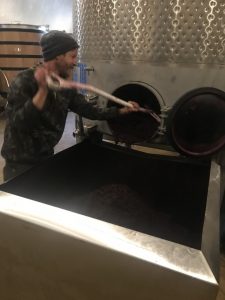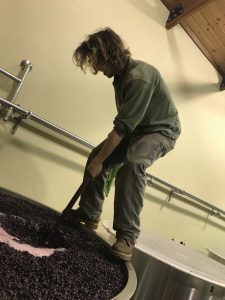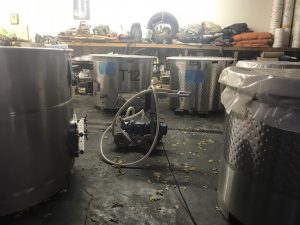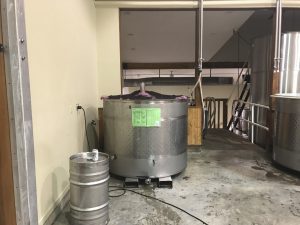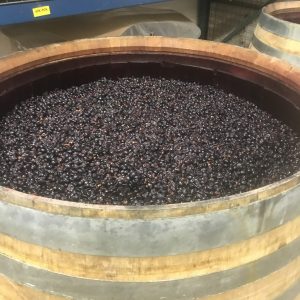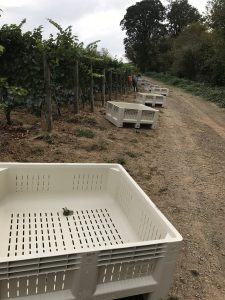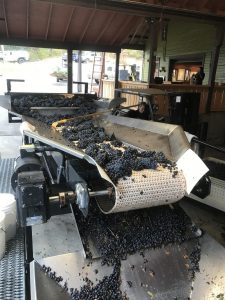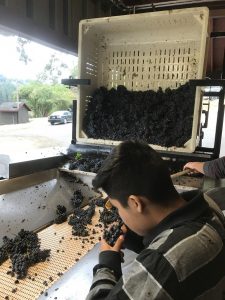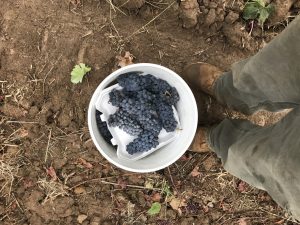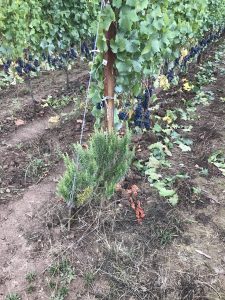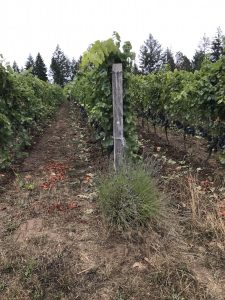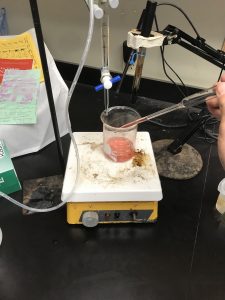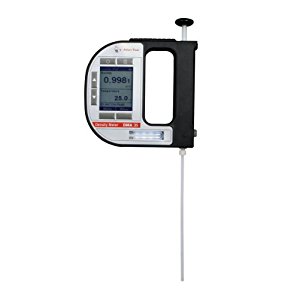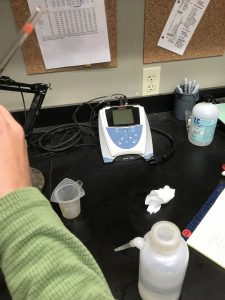This week I have not done much out of the usual. Just punch downs on the remaining tanks and gas in my fermenter everyday. I have noticed hints of VA in my tank. This is volatile acid, what they make balsamic vinegar out of. I think it is from moldy zinfandel grapes.
Category / Project Weekly
Week 8: Final week at Beaux Freres
A lot of tanks are getting pressed off. Pressing is done in cycles of 90-120 minutes which is very slow. The pressing is done slow so that the bad tannins are not released and the seeds are not crushed. Almost all of the tanks do not have doors on the bottom. This means that they must be scooped out with a bucket. First the tank is drained overnight so that there isn’t much juice in the tank. Then it is scooped into a press the get the remaining juice out.
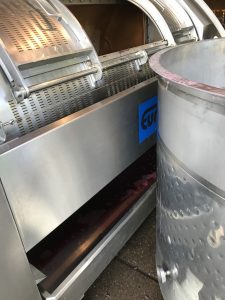
A bladder press is loaded with grapes. A bladder press works by basically having a huge balloon in it that squishes the grapes.
I left this week. It was quite sad leaving but I am ready to go. I really enjoyed working with everyone a lot and they were fantastic people. I thought it was a great experience and I would love to come back some day. Now time to work at my families winery which is called Saxum.
Week 7: Continuing the pump
I am still pumping but some tanks have been pressed off. Everyone is very tired but the hours are getting lesser. Everyone is very done with pumping but it must be done. Sometimes if we are very tired we dig the caps. This is like a punch down which mixes up the cap but it does not break as many berries. It is done instead of pumping and is a little faster since we can have all the pumps running and people doing this.
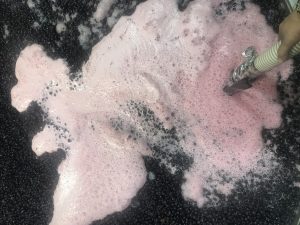
A fermenter is going off! One of the 5 ton tanks has started the most active part of fermentation. It is quite exciting to see. The sugar levels will drop very fast during this stage. The tank will also get much higher temperature, sometimes up to 95 degrees!
I have punched a couple tanks down too. At Beaux Freres they do a thing called POPs which means pump over punches. A punch down is normally done without someone pumping but when the grapes are suspended in the juice there will be less damage done. The goal as always is to not break the grapes.
Much more fruit came in than expected so the tanks are everywhere. The packaging room, the garage, the refrigerator truck, the tasting room, the sorting area.
Week 6: Pumping a lot.
This week consisted of only pumping and cleaning the pumps. Pump overs are done twice a day and there are 80+ fermenters. The majority of the tanks are 2 tons which are 10 minutes of pumping. There are some barrel fermenters which are 3 minutes of pumping and 5 ton tanks which require 15 minutes. I am pumping for around 12 hours a day, which is nice because I can listen to headphones.
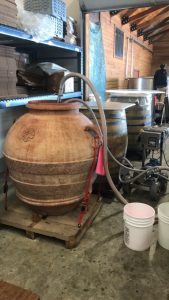
This is an amphora. It is similar to a barrel that it is porous so the flavor of the wine gets into the vessel. The main difference is that there is no oak flavor with the amphora.
Week 5: Sorting and PUMPIN!!!!
I continued to sort for another 52 hours but I would also take the occasional day off to pump over for that day. Pumping over is taking the juice from the bottom and putting it on the cap. Keeping the cap wet is good to avoid mold. It also helps the yeast. The way it was described to me is imagine that the tank is a city and the yeast live inside. They eat and poop all the time with no movement so they will eventually get sick. The pumping over is like cleaning it all up so that they yeast can remain happy with all the fresh juice. It is also used for temperature control. Some pumps are connected to glycol plates which let you cool the juice down so that it would remain cold and not start to ferment. This was called a cold soak, it’s used to get the flavor of the skins along with some other extractions. Then the temperature would then be increased when the fermentation was desired.
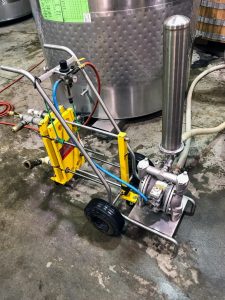
The yellow thing is the temperature plates and it is connected to an air pump. Glycol to cool down the wine and hot water to warm it up.
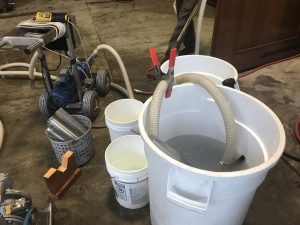
This is a flexible propeller pump getting cleaned. First it is ran through sodium percarbonate and then Sulfur Dioxide and Citric acid.
Week 4: A lot of sorting
This week I did a 21 hour day of sorting fruit. I did 121 hours of working but it was only sorting fruit. I would clean the line at the end of the day. My job for the line was washing the destemmer parts. This was almost always done after midnight so I never took pictures of it. It was the most tiring experience of my life. I was averaging 18 hours of work a day, after meals this left little time for sleeping.
Week 3: Fruit is coming in!
The fruit has start to slowly but surely come in. The first of the Pinot has come in from a vineyard that is off site. It is picked early in the morning with buckets and transported in macro bins. The pickers are paid per bucket so they are constantly running and picking as fast as they can. They do a great job and the picking is done within a couple hours.
Next the bins are sorted on the line. They are picked into 1/4 ton macro bins which is smaller than usual. They use small bins because they do not want the grapes to be crushed and to lose juice. The bins are loaded onto a hydraulic dumper and raked out gently. The leaves, mold (we had lots of botrytis sadly), and raisins were sorted out. The grapes would then go through the destemmer so that berries alone would end up in the tank. Sometimes the destemmer would be taken apart but rarely.
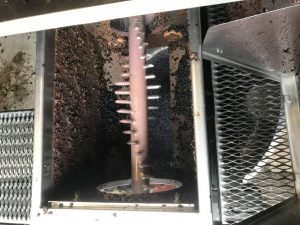
The cage of the destemmer is taken off in this picture this allows the grapes to pass without leaving the stem. They will occasionally put in a little bit of whole cluster. Whole cluster is used for different tannin structure and flavors.
Week 2: Sampling and Bottling!
In my last post I said what my lab work involved. To get those measurements to be accurate to the block in the vineyard, the fruit should be picked evenly. To do this imagine a 16 row vineyard, you would pick 4 clusters on a row and then skip 4 rows so that you would have 16 clusters that were from all over the block. While taking the samples for the lab, it is also good to do yield estimates. To do this when I would pick a cluster I would count every cluster on the next 5 plants. So in the end I would get 16 numbers. These numbers and total weight of the clusters were used to figure out much fruit that block would have.
Sadly, I do not have any pictures of bottling. I had a very simple job during bottling though, I put bottles onto a conveyor belt. They went into to get filled with wine, corked, foiled, labelled and then put into boxes.
Week 1: Lab Work!
Along with Lab work I was also sampling and bottling but in this post I shall describe my time in the lab. It was to figure out the Brix (sugar level), TA (titrable acidity), and pH (acidity) of samples from different vineyards to decide when they should be picked.
Titrable Acidity is the amount of acid found the sample. It is figured out by taking a 5 ml sample of must (grape juice) and putting it with 25 ml of water. Next you put it on a magnetic stirrer and insert a pH reader. NaOH (sodium hydroxide) is slowly added through a burette until the pH is at 8.2. You put all of your numbers into this formula:
g/L = ml NaOH x normality NaOH x 0.075 X 1000
Project Weekly Posts
Weekly post that addresses student’s exploration of your ILC learning objectives, activities and outcomes; specifically a weekly post that explores answers to the questions in the Learning Objectives.
